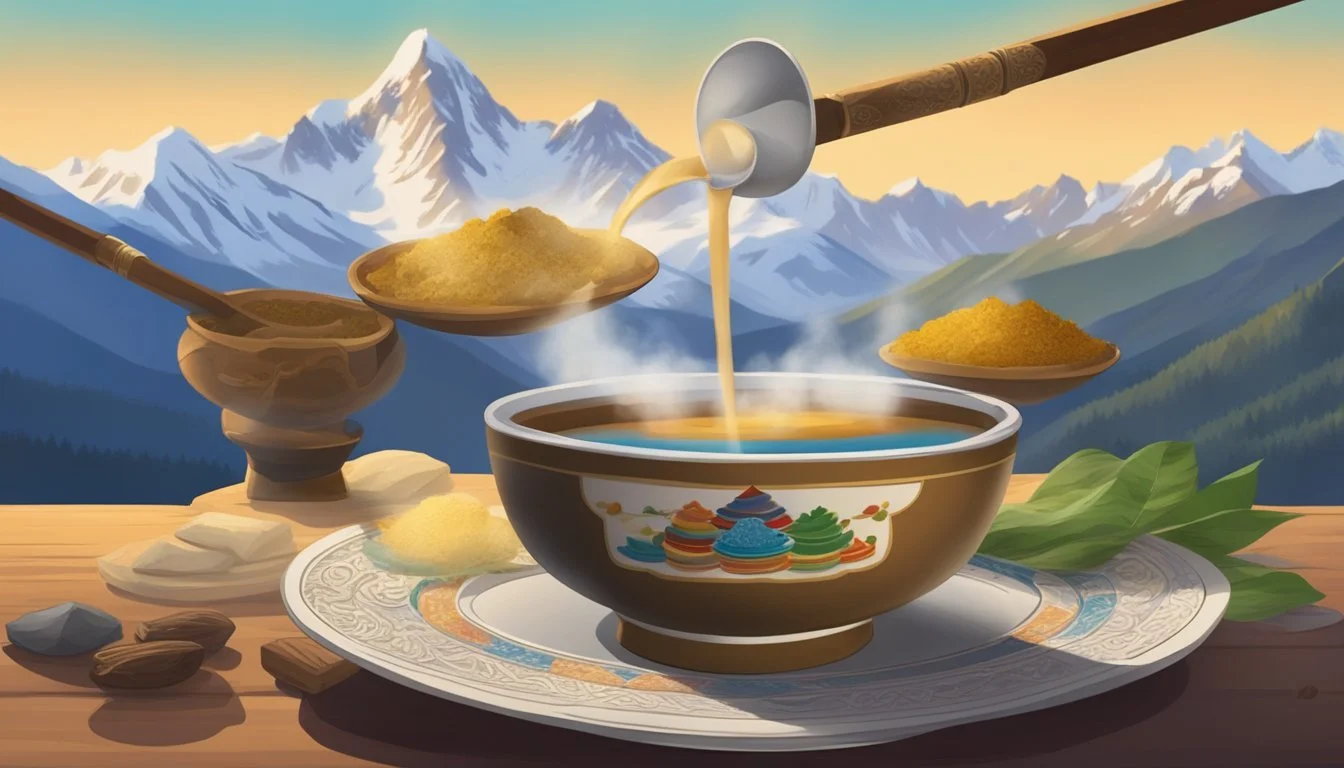Yak Butter Tea
Unveiling the Secrets of Tibet's Energizing Elixir
Yak Butter Tea, also known as Po Cha, is a quintessential Tibetan beverage, deeply entwined with the fabric of life in the high-altitude Himalayan region. This traditional drink is not just a means of hydration but a source of sustenance for the Tibetan people, who often grapple with harsh climatic conditions. The tea is made from a few simple ingredients: tea leaves, yak butter, water, and salt. The unique combination provides essential calories and nutrients, making it an ideal drink for the cold, thin air of the Tibetan plateau.
The process of making Yak Butter Tea involves boiling tea leaves, churning the mixture with yak butter, and adding a sprinkle of salt to enhance the flavor. This results in a rich, creamy concoction that might surprise those unfamiliar with its distinct taste and texture. The tea's high caloric content is particularly beneficial for Tibetans, supporting their energy needs in the demanding high-altitude environment where the air holds less oxygen and temperatures often plummet.
The significance of Yak Butter Tea in Tibetan culture cannot be overstated. It is more than a mere beverage; it is a symbol of hospitality and a staple in daily life. In many Tibetan homes and monasteries, it is consumed multiple times a day, reflecting its role in social functions and spiritual practices. Moreover, its nutritional profile helps locals withstand the cold and cope with the physical demands of life at high altitudes, reinforcing its practicality and cultural importance.
Historical Significance
Yak Butter Tea, a centuries-old staple of Tibetan culture, has its historical significance deeply rooted in the practicalities of surviving Tibet's harsh climate. It not only provided essential nourishment but also became a symbol of hospitality across the Himalayan region.
Origins in Tibetan Culture
Tibetan Plateau: The origins of Yak Butter Tea can be traced back to the Tibetan Plateau, where the extreme conditions necessitated a high-calorie and warming beverage. This traditional drink, known as po cha, emerged as a critical source of energy and warmth for Tibetans.
Ingredients: Primarily consisting of yak butter, tea leaves, salt, and water.
Cultural Importance: Integral to social functions, including rites of passage and daily family life.
Spread Across the Himalayas
As Tibetan influence expanded, so did the reach of Yak Butter Tea. It moved beyond the Tibetan Plateau into neighboring regions within the Himalayas, especially into areas with similar altitudes and climates.
Bhutan and Northern India: Adopted and integrated into local dietary habits, each region added its twist to the recipe.
Cultural Exchanges: The beverage became a means of cultural exchange among high-altitude communities throughout the Himalayas.
This historical progression of Yak Butter Tea underscores its role as a nutritional necessity and a cultural linchpin in the daily lives of Himalayan peoples.
Cultural Importance
Yak butter tea holds a significant place in Tibetan culture, serving as a crucial component in daily nutrition as well as a beverage deeply rooted in social customs and hospitality.
Daily Life of Tibetans
In Tibetan society, yak butter tea, or boe cha, is far more than just a beverage; it constitutes an essential part of the Tibetan diet. Each day, Tibetans consume the tea multiple times, with some drinking it as often as a dozen times. This frequent consumption supports the high-calorie needs of a population living at such elevated altitudes. For the nomadic people of Tibet's Amdo region, the similar salty milk tea takes precedence as a practical adaptation to their economic circumstances.
Rituals and Etiquette
Yak butter tea is steeped in ritual significance and etiquette in Tibetan culture. Offered to guests upon arrival, it acts as a gesture of hospitality and warmth. Monks often drink yak butter tea to aid in meditation and maintain energy levels during long ceremonies. The act of serving and accepting the tea follows a cultural etiquette: guests typically receive cha süma, or three servings of tea, a practice signifying respect and a warm welcome.
Variant Names Across Regions
As regional customs vary, so do the names given to yak butter tea. While boe cha is widely recognized, goor goor cha references the traditional method of churning the tea in a cylindrical wooden churn. In some regions, locals refer to the tea as cha suskan, emphasizing the personalized ways in which the tea is integrated across different Tibetan communities. Each name, whether boe cha, cha suskan, or goor goor cha, encapsulates the unique regional nuances of this high-altitude brew.
Health and Nutrition
Yak Butter Tea, a staple in the Tibetan diet, is revered for its nutritional benefits, especially in the harsh climate of the Himalayas. It is calorie-dense and provides vital warmth and energy to those who consume it.
Energy and Warmth
In the high-altitude, cold regions of Tibet, Yak Butter Tea acts as a critical energy source. The tea contains calories which are essential for sustaining energy levels throughout the day. The high-fat content in yak butter provides a slow and steady release of energy and, most importantly, warmth to combat the freezing temperatures.
Benefits in Tibetan Medicine
Tibetan medicine views Yak Butter Tea as a substance with the ability to promote mind-body balance. It is said to support heart and brain health, while also being beneficial for the skin and immune system. The traditional belief is that the tea aligns with Tibetan medicinal practices, which emphasize harmony within the body.
Caloric and Fatty Content
The composition of Yak Butter Tea is high in caloric and fatty content. Here is a brief breakdown:
Component: Calories
Content: High
Component: Fats
Content: Saturated & Unsat.
This caloric density provides essential sustenance, while the fats contribute to the rich, creamy texture and sustaining energy levels. However, it is important to consider that, for those monitoring their fat intake, Yak Butter Tea contains a significant amount of saturated fats.
Ingredients and Variations
Yak Butter Tea, also known as Po Cha, is a unique highland concoction that brings warmth and energy to the Tibetan population. This section delves into the specifics of its preparation, including its core components, regional tweaks, and alternative ingredients suitable for those without access to traditional elements.
Core Components in Traditional Recipe
Yak Butter: Integral for richness and calories, yak butter is stirred into the tea.
Black Tea: Forms the base; usually a strong brick tea like Pu-Erh is favored.
Salt: Added to enhance flavor, balancing the robust notes of the butter and tea.
The traditional preparation method involves boiling water with brick tea until it forms a strong brew. Yak butter and a pinch of salt are then churned into the tea, creating a frothy, calorie-dense beverage suited to the high-altitude climate of Tibet.
Regional Adaptations
Milk or Cream: In some areas, milk or cream may be added to introduce additional creaminess.
Half-and-Half: Regions with milder climates might prefer half-and-half, resulting in a lighter version of the tea.
Tibetans living at different altitudes and geographical areas adapt their butter tea recipes according to local taste and ingredient availability. While the core ingredients remain consistent, the ratios and preparation methods can vary, reflecting the diverse palate within the Tibetan culture.
Substitutes for the Western Palate
Cow's Butter: Can replace yak butter, although it alters the authentic taste.
Pu-Erh Tea: A common substitute for Tibetan brick tea, available in specialty stores.
Cream or Half-and-Half: Easier to find in Western kitchens and can mimic the richness of yak milk.
In the absence of yak butter, Western enthusiasts tend to use cow's butter, along with readily available black teas like Pu-Erh. While these substitutes can differ in flavor from the original ingredients, they allow those outside of Tibet to experience a version of this distinctive high-altitude brew.
Preparation Techniques
Yak Butter Tea, also known as Po Cha, is a staple of Tibetan life, providing essential calories and warmth in the harsh, elevated climates. This section explores the traditional and modern preparation methods, along with the tools needed to make this nourishing brew.
Traditional Brewing Methods
Traditionally, Tibetans prepare Po Cha by first boiling water and steeping tea leaves, typically a strong black variety. The tea is then simmered for a few hours to create a rich base. A significant amount of yak butter—which is high in calories and beneficial fats—is then mixed into the tea. The integration of salt makes it a savory drink. The mixture is then vigorously churned in a cylindrical container called a chandong to create a smooth, emulsified liquid.
Sample Recipe (for communal serving):
Boil 4 cups of water.
Add 2 heaping tablespoons of black tea leaves.
Simmer for a couple of hours.
Strain the tea leaves.
Mix in about 1 tablespoon of yak butter per cup.
Add salt to taste.
Churn the mixture either manually or using a mechanical device until well blended.
In conjunction with Po Cha, Tsampa, a form of roasted barley flour, is often consumed. They mix a small handful of Tsampa into their tea to form a thick, nourishing paste.
Modern Adaptations
As lifestyles evolve, so have the ways in which Po Cha is made. Those who may not have access to traditional tools have employed blenders to emulsify the ingredients, significantly reducing the preparation time. Modern recipes sometimes suggest brewing the tea for less time or using fewer tea leaves to cater to different palates.
Quick Recipe (for individual serving):
Boil 2 cups of water.
Steep 1-2 bags of black tea or an equivalent amount of loose tea leaves for 3-5 minutes.
Remove the tea and blend with 2 tablespoons of butter and a pinch of salt until frothy.
Tools and Utensils
The traditional method requires a chandong, which is a long, cylindrical, wooden container traditionally used to churn the mixture. For modern methods, a standard blender suffices to blend the ingredients. To measure the ingredients, a measuring spoon and cup are necessary to ensure the right proportions for the recipe. When serving Po Cha, one typically uses a small, handle-less bowl.
Comparative Analysis
In this section, we dissect the characteristics of Yak Butter Tea and compare it with Bulletproof Coffee, highlighting their distinctiveness and points of convergence with other butter-infused beverages.
Yak Butter Tea vs. Bulletproof Coffee
Yak Butter Tea, a staple in Tibet, is primarily made from tea leaves, yak butter, water, and salt. In contrast, Bulletproof Coffee combines coffee with unsalted butter and medium-chain triglyceride (MCT) oil. Yak Butter Tea offers a blend of fat and salt which caters to the nutritional needs of high-altitude climates.
Bulletproof Coffee is often regarded as a modern nootropic drink, designed to enhance mental clarity and energy. The table below highlights key differences:
Aspect: Main Ingredient
Yak Butter Tea: Tea
Bulletproof Coffee: Coffee
Aspect: Fat source
Yak Butter Tea: Yak butter (high in calories)
Bulletproof Coffee: Grass-fed cow butter & MCT oil
Aspect: Taste
Yak Butter Tea: Salty
Bulletproof Coffee: Creamy and slightly sweet
Aspect: Purpose
Yak Butter Tea: Nutritional sustenance; warmth
Bulletproof Coffee: Mental clarity; sustained energy
Aspect: Origin
Yak Butter Tea: Himalayan region, Tibet
Bulletproof Coffee: Modern health-conscious communities
Similarities to Other Buttered Drinks
While distinct in their origins, Yak Butter Tea and Bulletproof Coffee echo a broader tradition of fat-enriched beverages. Both drinks offer a high-calorie boost, which can be vital for sustaining energy in demanding situations. The practice of adding butter to beverages is not unique; other cultures also incorporate dairy into their drinks for added sustenance. The incorporation of dairy in the form of butter is the common thread tying these drinks across different cultures, though the type of dairy can differ, such as using ghee in Bulletproof Coffee as an alternative to butter.
Culinary Experience
In the realm of Tibetan cuisine, yak butter tea is not just a beverage—it's an emblematic culinary experience. Its unique taste profile and caloric richness are especially valued in the harsh climate of the Himalayas.
Taste Profile
The taste of yak butter tea is distinctive, comprised of a rich, creamy texture with a notably salty flavor profile. The primary ingredients are fermented pu'erh black tea and fermented yak butter, which contribute to its pungent and robust character. Consumed in sips, it imparts a lingering warmth that is particularly beneficial in cold environments.
Acquired Taste for Newcomers
Many newcomers find the flavor of yak butter tea to be an acquired taste, due in part to its rancid notes which come from the fermented yak butter. To a palate unaccustomed to the drink, it may initially seem overpowering or unusual. However, with time, one may grow to appreciate its depth and the energy it provides.
Pairing with Tibetan Foods
Yak butter tea pairs well with traditional Tibetan foods (What wine goes well with Tibetan food?). Here are common pairings:
Tsampa: Roasted barley flour mixed with yak butter tea to form a dough-like substance.
Chaku: This sweet confection made from black molasses complements the salty flavor of the tea.
This combination not only doubles the nutritional value but also balances flavors, enriching the overall Tibetan dining experience.
Societal Impact
Yak butter tea, known locally as "po cha," is far more than a beverage in Tibet; it unites tradition with the necessities of living at high altitudes, serving as a symbol of national identity while providing an energy boost to its consumers.
Symbol of Tibetan Identity
For Tibetans, yak butter tea is integral to their daily life and is deeply entwined with their cultural identity. It is commonly consumed multiple times a day, and is offered to guests as a sign of hospitality. Nomadic people across the region also share this drink, reflecting a sense of belonging and community cohesion. The drink's prevalence has thus made it a national drink and an emblem of Tibetan culture.
Beverage of the High Altitudes
At the extreme high altitudes of the Himalayan region, the caloric density and warmth of yak butter tea are invaluable. Its combination of tea, rich yak butter, and salt provides an essential energy boost to Tibetans, helping to combat the harsh, cold climate. Especially among nomadic people, this potent brew fulfills a practical role in sustaining their energy levels while they navigate the challenging terrains of their homeland.
Conclusion
Yak Butter Tea stands as a testament to Tibetan heritage, encapsulating the resiliency and adaptability of the local population. This high-altitude brew is deeply woven into the cultural fabric, routinely served to guests and consumed daily by the Tibetans. It provides essential calories, warmth, and hydration, fulfilling practical needs in the harsh Himalayan environment.
In its preparation, yak butter, tea leaves, water, and salt merge into a distinctive concoction. The drink's nutritional value is noteworthy; it offers sustenance in a region where resources are scarce. Furthermore, it acts as a social lubricant, fostering community ties and hospitality.
Tibetan heritage is rich and diverse, and Yak Butter Tea is synonymous with this legacy. The drink is not merely a beverage but also an emblem of identity, signifying the unique lifestyle and the spirit of Tibet. It symbolizes endurance, a harmonious relationship with nature, and the importance of tradition in guiding daily life.
In understanding Yak Butter Tea, one gains insight into the broader cultural tradition of Tibet. It is a custom that has endured generations, sprouting from necessity but flourishing into a cherished ritual. This traditional high-altitude brew stands as a cultural pillar, underlining the significance of maintaining practices that define a community.
The recognition of Yak Butter Tea goes beyond its borders, intriguing outsiders and drawing in those keen on experiencing bits of Tibetan life. It is a culinary heritage that invites interest and respect for its rich cultural context and the continuity it represents for the people of Tibet.





